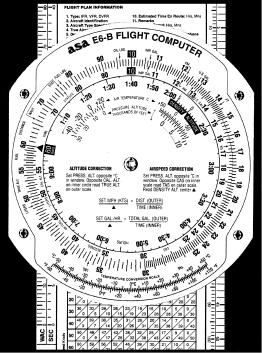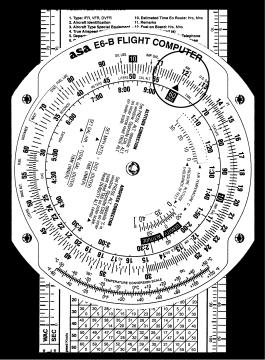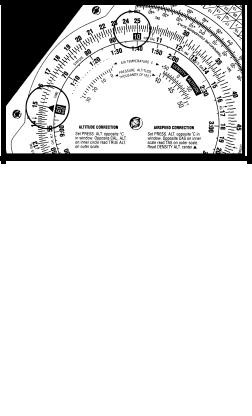ASA AIR CLASSICS E6-B User Manual

E6-B Flight Computer Instructions
This instruction booklet can be used with the three different E6-B models available from ASA. If you have a different model than the one depicted, some parts of your computer may appear slightly different from the computers pictured in this booklet. However, the calculations are accomplished with the same method and produce the same answers.
© 1992 – 2000 ASA
Aviation Supplies & Academics, Inc.
7005 132nd Place SE
Newcastle, WA 98059-3153
All rights reserved. Reproduction in whole or in part of this text is strictly prohibited and unlawful without the written permission of Aviation Supplies & Academics, Inc.
ISBN 1-56027-421-2
ASA-E6B
2
Contents |
|
|
Page |
Instructions for Using ASA Flight Computer |
...... 4 |
The Slide Rule Side .......................................... |
5 |
Time, Speed, and Distance Problems .............. |
8 |
Fuel Consumption Problems ........................... |
11 |
Conversions .................................................... |
13 |
Nautical to Statute Miles ............................ |
13 |
U.S. Gallons to Imperial Gallons ................ |
15 |
Quantity/Weight Conversions ..................... |
16 |
Using the Altitude and Speed |
|
Correction Windows ........................................ |
18 |
True Airspeed and Density Altitude ................ |
18 |
Converting Mach Number to True Airspeed.... |
20 |
True Altitude .................................................... |
21 |
Feet Per Mile vs. Feet Per Minute ................... |
22 |
Off-Course Problems ...................................... |
24 |
The Crosswind Table ...................................... |
27 |
The Wind Side of the Slide ............................. |
28 |
Determining Winds in Flight ............................ |
32 |
Answers to Sample Problems ......................... |
37 |
3

Instructions for Using ASA Flight Computer
Your ASA E6-B Flight Computer has two main parts: a circular slide rule side for making quick calculations, and a wind side for computing ground speed and wind correction angle. The slide portion of the circular slide rule side also includes quickreference material.
Figure 1
4
The Slide Rule Side
The term “circular slide rule” shouldn’t be intimidating. This side of your computer simply consists of a rotating disk with numbers on the middle scale, which when set against similar numbers on the fixed portion (outer scale), allows you to solve problems of time, speed, and distance, calculate fuel consumption, and make conversions between measurements such as statute and nautical miles. The inner scale on the rotating disk is graduated in hours. The slide rule side also has “windows” that you will use to solve airspeed and altitude problems.
You can see that the number 60 on the rotating disk is marked differently than the other numbers. That is because most of your problems will be concerned with time —“something” per hour, either miles or gallons. Before you get to that, you should learn how to read and interpret the numbers on both portions of the slide rule side.
Rotate the disk until all of the numbers on the middle scale match up with the numbers on the outer scale —10 will be at the top. However, that number “10” may be read as “.1,” “1,” “100,” or “1,000” depending upon the context of the problem. For now, read it as 10. The next number to the right is 11, so each life (or mark) of calibration between the two numbers is equal to .1, and you would read them as 10.1, 10.2, 10.3, etc. If you were solving a problem involving 1,000 pounds of fuel, the number 10 would be read as 1,000, and each calibration would be equal to 10 pounds, and the 11 would be read as 1,100 pounds. See Figure 1.
5
Now look at the number 15 on the disk. Between 15 and 16 each calibration mark is equal to .2 and would be read as 15.2, 15.4, etc. If you were solving a problem with an airspeed of 150 knots, the first calibration past 15 (150 in this case) would be 152. The spacing changes again at the number 30, where each calibration becomes .5, and at 60, where each calibration equals 1. Before you read a value from the disks, be sure you understand what each line of calibration is equal to.
You will use the slide rule side to establish ratios. With the numbers matched, the ratio is 1 to 1. Now set the number 60 (the rate arrow) directly opposite to (or, “lined-up” with) 12 on the outer disk (see Figure 2). Notice that all of the numbers on the outer disk are exactly twice the value of the numbers on the inner disk: 90 is opposite of 180, 15 is opposite of 30, 3.5 is opposite of 7.0. You will use these ratios in solving time-speed-distance and fuel consumption problems.
Look at the inside scale on the disk, where the lines of calibration look like clock times: 9:00, 6:00, etc.— these express hours. The inner scale is in hours and the middle scale is in minutes. 1:10 is directly below 70; one hour and ten minutes is the same as seventy minutes. 5:00 is printed below 300 minutes, and five hours is the same as 300 minutes. To convert minutes to seconds, place the rate arrow opposite to the minutes on the outer scale and read seconds opposite to the “seconds” arrow, just to the right of 35 on the inner scale.
6

Figure 2. Line up the number 60 (the rate arrow) with the number 12 on the outer disk (or, scale).
7
Time, Speed, and Distance Problems
The rate arrow on the disk is always set to indicate a value per hour on the outer scale. There are three basic time-speed-distance problems. In two of these problems you know the rate, while in the third problem, the rate is part of the answer you are looking for.
To find the Time En Route, let’s assume you know your airspeed is 150 knots (nautical miles per hour).
1.Set the rate arrow to 150. See Figure 3.
2.You have determined the distance to your destination to be 245 nautical miles. Speed and distance are always on the outer scale; 245 is halfway between 24 and 25.
3.Look directly opposite to that value on the inner scale to find the Time En Route. It is between 1:35 and 1:40. There are five calibration marks on the middle scale between 1:35 and 1:40, and 245 NM on the outer scale is closest to the third calibration, or one hour and 38 minutes.
To find out how far you can go if your fuel endurance is 4.5 hours and your ground speed is known to be 125 knots:
1.Set the rate arrow at 125 on the outer scale. See Figure 4.
2.Find 4:30 on the inner scale.
3.The value on the outer scale is slightly more than 55. You know that 4 hours at 125 knots should cover 500 miles, so the outer scale is read as 500, not 50 or 5,000, which makes each large calibration mark worth 10 nautical miles. The answer is 564 nautical miles.
8

Figure 3
Figure 4
9

In the final and most common type of time-speed- distance problem, the time and distance are known, and you need to solve for unknown speed. The rate arrow represents the answer. You will have flown between two known ground reference points 26 NM apart and checked the time between them to be: 13 (thirteen minutes, that is, not thirteen hours).
1.Set thirteen minutes on the middle scale opposite to 26 on the outer scale. See Figure 5.
2.The rate arrow points to your ground speed, 120 knots.
Figure 5
Try these time-speed-distance problems:
(Answers are on Page 37)
|
SPEED |
TIME |
DISTANCE |
||
1. |
125 KTS |
|
524 NM |
||
2. |
|
|
2:30 |
345 |
|
|
|
||||
3. |
110 KTS |
1:40 |
|
|
|
4. |
|
|
0:24 |
44 |
|
5. |
95 |
|
1:24 |
|
|
10

Fuel Consumption Problems
Problems involving fuel consumption, fuel endurance, and fuel capacity are solved using the same numbers you used in the time-speed-distance problems. With the exception of time values, only the names change.
Assume that your airplane’s Approved Flight Manual indicates fuel consumption of 8.4 gallons per hour at a given power setting and that the usable fuel capacity is 64 gallons. How many hours endurance do you have in the tanks?
1.Line up the rate arrow (“something per hour”) with 8.4 on the outer scale. See Figure 6.
2.Now find 64 on the outer scale.
3.Opposite of 64, read fuel endurance in hours: 7:37 on the inner scale. The outer scale, which was used for speed and distance, is now used to indicate gallons per hour and fuel capacity.
Figure 6
11

When you paid for your fuel you noted on the delivery ticket that it took 32 gallons to top the tanks. You flew four hours and twenty minutes before stopping for fuel. What was the average fuel consumption? This time the rate arrow provides the answer.
1.Set 4:20 on the inner scale (or 260 on the middle scale) opposite of 32 on the outer scale. See Figure 7.
2.The rate arrow indicates the average fuel burn rate: 7.4 gallons per hour.
Remember that fuel consumption is greater during the climb to altitude, so this average value does not accurately reflect fuel consumption in cruising flight.
Figure 7
Try these examples:
(Answers are on Page 37)
|
GALLONS PER HOUR |
TIME |
TOTAL USED |
|||||
1. |
7.8 |
|
3:20 |
|
|
|
|
|
2. |
|
|
|
4:50 |
62 |
|
||
|
|
|
|
|||||
3. |
8.5 |
|
|
38 |
|
|||
4. |
10 |
|
2:30 |
|
|
|
|
|
5. |
12 |
|
|
22 |
|
|||
12
